Construct An Organization Chart For The New Century's Office Staff
An organizational chart (also called an organization chart, and usually shortened to org chart) is a visual representation of the roles and reporting structure of a team, department, division, or an entire company. In this tutorial, you'll learn to easily create and modify org charts using Microsoft Word in a few minutes.
What Is an Organizational Chart?
An organizational chart, also called an org chart or organization chart, is a visual tool that shows the reporting relationships in an organization. New employees can use org charts to learn the structure (i.e who reports to whom) of their department or any related department. Managers use org charts to illustrate their function and the function of their employees as part of the larger organization, or to evaluate the responsibilities of different roles before and after restructuring. Org charts are also a useful tool for mapping groups beyond departments in large corporations, from volunteer organizations to family trees.
Besides the obvious use of visualizing the reporting structure, org charts can be a practical tool to use in many situations, including the following:
-
Evaluating the functions of departments and of employees
-
Planning cross-department projects
-
Planning and evaluating restructuring efforts
-
Tracking workloads of individual employees and of managers to determine who has too much or too little work
The easiest way to read an organizational chart is from the top to bottom. Most org charts are pyramid shaped, with the highest-ranking person at the top. Each row is a level of management, so the chart widens as it maps the lower levels of the organization. Lines connect shapes to show reporting relationships.
Keep your employees connected, informed, and engaged with Smartsheet
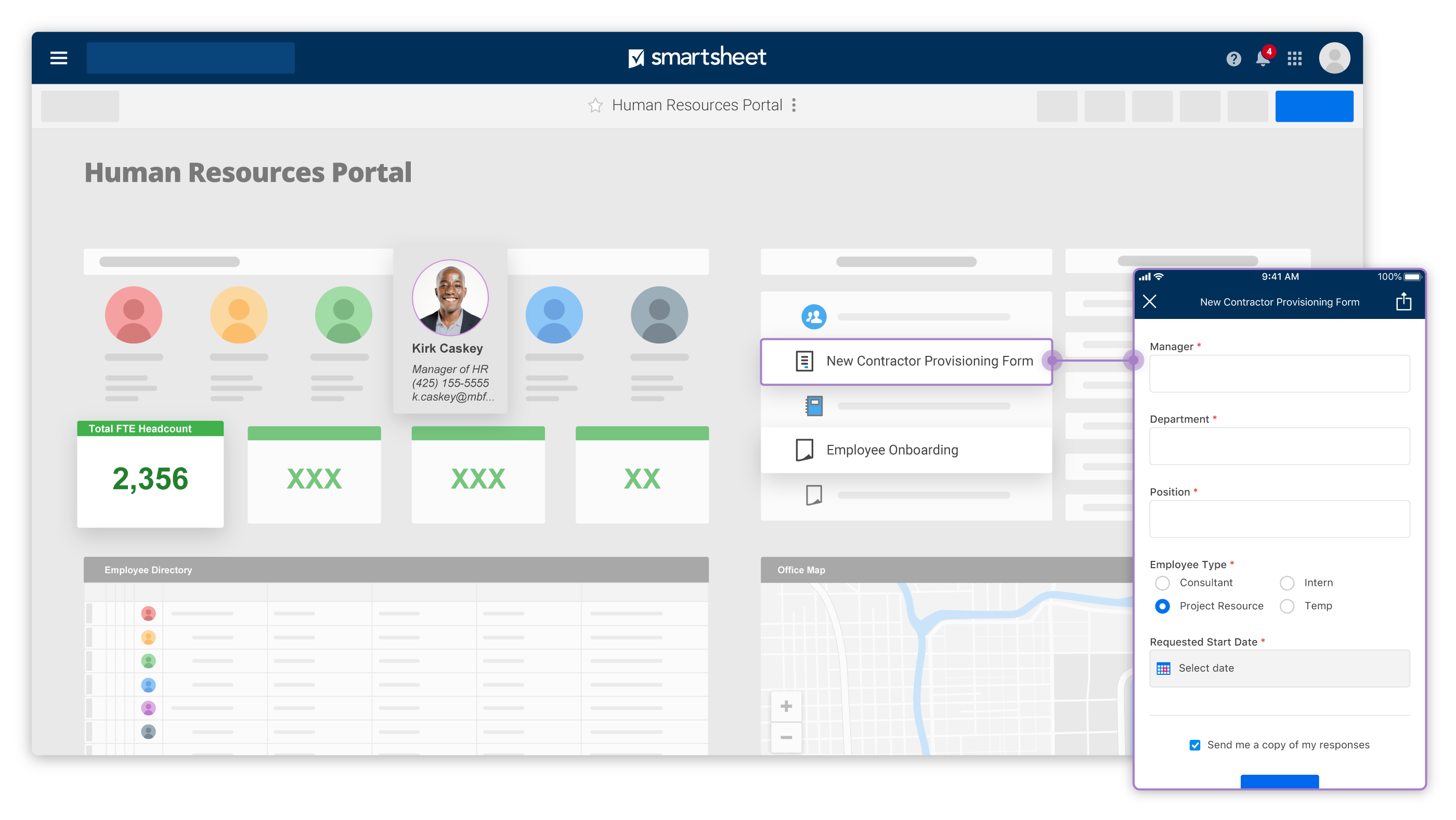
Smartsheet is a cloud-based platform that enables HR teams to manage everything from job applicant tracking to new hire onboarding and employee performance reviews. See Smartsheet in action.
Watch a free demo
How to Make an Org Chart in Word
The easiest way to create an org chart in Microsoft Word is to use the SmartArt tool. In Word 2010, 2013, and 2016 for Windows and Word 2016 for Mac, as well as the Office 365 version, you can find the SmartArt feature by clicking on the Insert tab and clicking the Illustrations group. In Word for Mac 2011, SmartArt is a tab. Instead of starting from scratch, you can also create an org chart from one of the free templates available from Smartsheet to save time.
Note: All screenshots in this article are from Microsoft Word for Mac 2011. Other versions of Word will have variations in how the items appear, but the steps are similar. You can also use the SmartArt feature in Excel to create an org chart.
- Open a blank Microsoft Word document and click the Insert tab, click SmartArt, click Hierarchy, and then click Organization Chart.
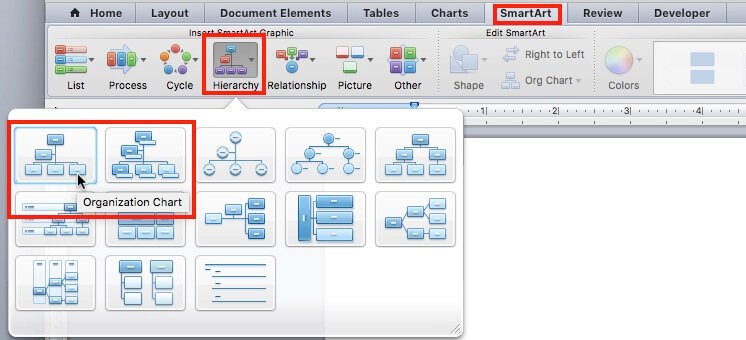
- The top shape (a rectangle in this example) is for the head of the organization. Click the shape (you may need to move or hide the text pane) and enter the name of the person. Hit return or shift+return to start a new line to enter a title or other information. The text will automatically resize to fit inside the shape.
- The shape just below the top position is for an assistant. Click the shape and enter their information.
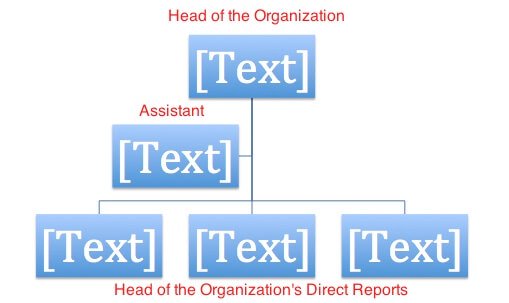
- The next row of shapes are for people reporting to the leader of the organization. Click each one and enter each person's information.
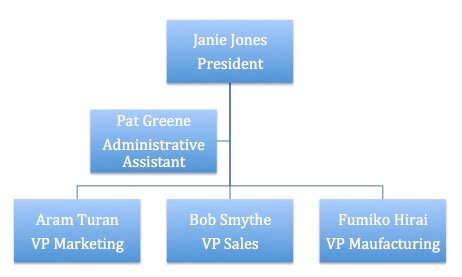
Using the Text Pane
In addition to adding or editing text in a shape (which are also called autoshapes), you can add or edit text in the text pane.
In the text pane, the L-shaped icon represents an assistant. Bullet points correspond to all other positions.
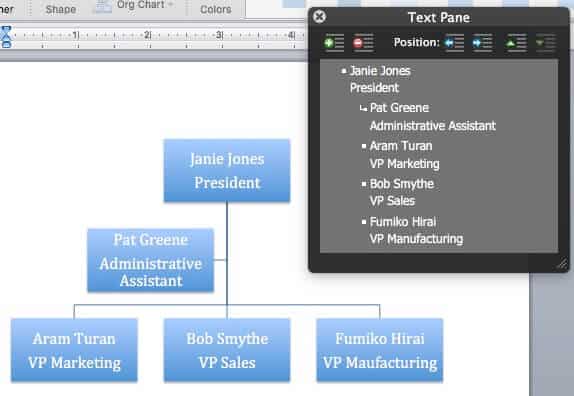
The text pane is the easiest way to add or delete new shapes, as well as move shapes up or down levels. If the text pane isn't visible, click the text pane tab (marked in red in the image below).
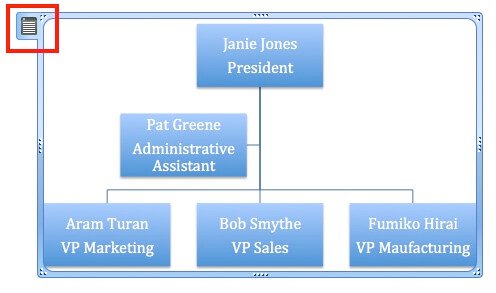
How to Make Changes to an Organizational Chart in Word
Once you create an org chart, you can easily make changes to it by using tools in SmartArt.
If the changes need to apply to all shapes (such as the background color or the shape itself) or all text (such as a font or color), use the Select All command from the Edit menu before making the change.
Add a Shape: Select a shape (the default shape is a rectangle) and click the plus button on the text pane. The new shape will be added on the same row as the selected shape. A couple things to note:
- If no shape is selected, the new shape will not be connected to the other shapes, and will appear on the same level as the top shape in the chart.
- If a direct report is selected when adding a shape, the new shape will also be a direct report to the same position.
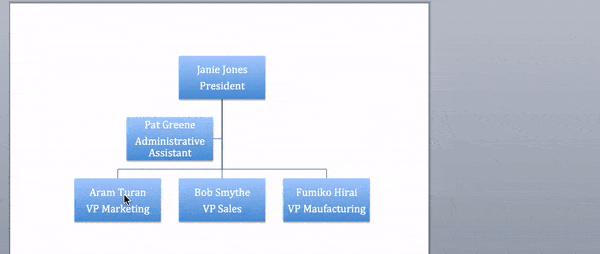
Add an Assistant: If the org chart already has an assistant, select that shape and follow the directions above to add a shape in the text pane.
If the assistant box has been removed, or if an assistant is needed for another position, click the shape where you add the new assistant shape, then click SmartArt in the ribbon, click Org Chart, and click Add Assistant.
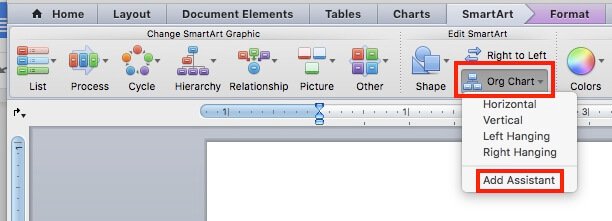
Resize a Shape: Click the shape, then drag the handles on the corners or sides to make the shape larger or smaller.
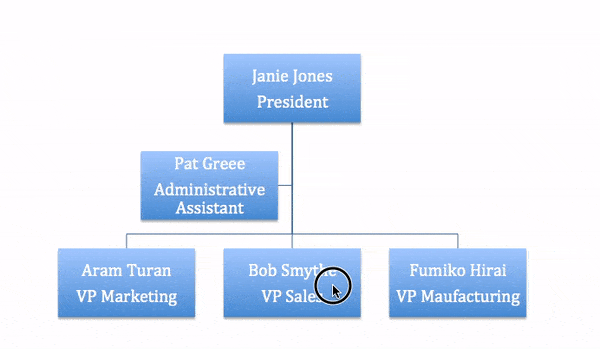
Add a Direct Report: Right-click a shape and click Add Shape and choose Add Shape Below. The new shape will be in a subordinate position.
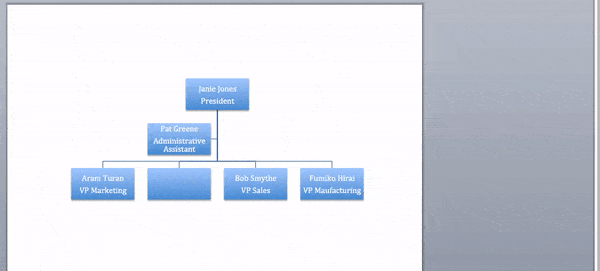
Delete a Shape: Click the shape (in an area that doesn't include text), and then click the minus button on the text pane.
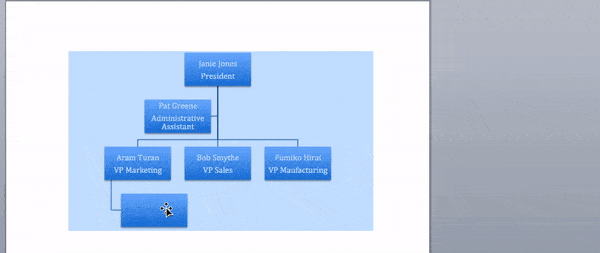
Change the Text: This is no different than changing other text in Word: Highlight the text, and then change the font, the color, the size, or any other aspect using the options in the Home tab.
Change a Shape's Background: Right-click on a shape, click Format shape, click Fill, and choose an option.
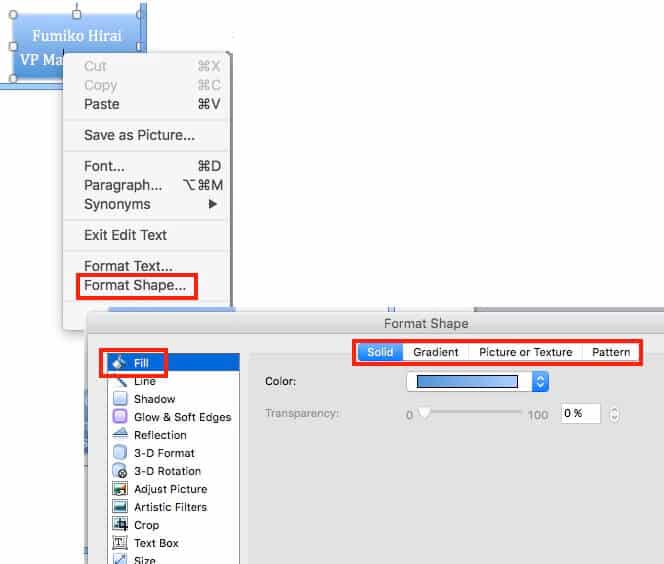
Change the Layout: Click the Hierarchy menu on the SmartArt ribbon to change the layout of your org chart.
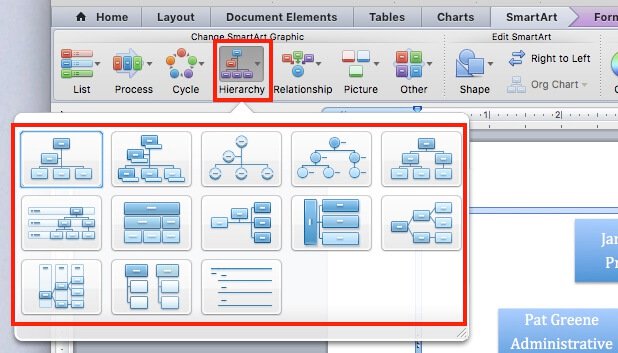
Change the Design: Select the chart, then choose an option from SmartArt Graphic Styles. These options will differ based on the selected layout.

Add Pictures: If you want to include pictures of the people in each position, you can add them as background images (see "Change a Shape's Background" above).
Another option is to select the Circle Picture Hierarchy layout, then add a picture for each position by clicking on the placeholder and inserting an image.
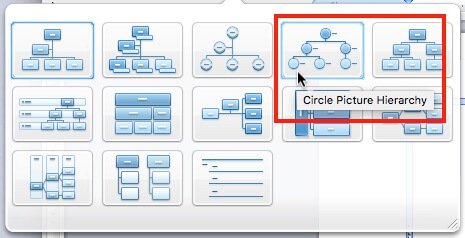
After you add the pictures, it'll look something like this:

Modify a Relationship: The easiest way to change a relationship (e.g. if a person moves to a new manager) is to delete the shape from under the former manager and add a new shape under the new manager. Follow the steps for deleting a shape and adding a shape outlined above.
Adding a Line: You can include connector lines by adding a shape that's linked to another shape.
Some Org Chart Design Considerations
The default design works well for many situations, but users have a great degree of control over the appearance of each element in the chart. However, to keep the org chart easy to read, it's best to keep the design consistent and simple. Not all charts include titles, but it's common to list the person's name first and their title on the next line. If you want the titles first, enter the information in that order.
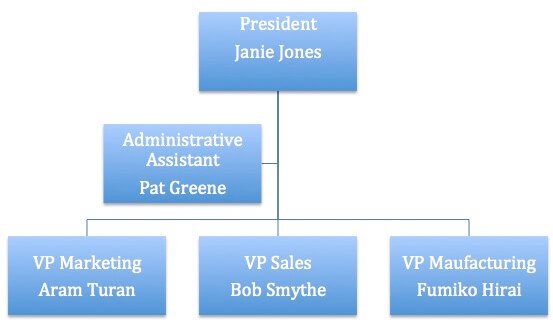
What You Can Do with an Org Chart Once It's Complete
Once you have a chart, you'll want to use it and share it with others. Options abound, but here are some suggestions for ways you can display it:
-
Save the Chart as a Picture: Right-click the chart, and then click Save as picture. It's easy to include the picture as part of a web page, or import it into documents.
-
Print the Chart: If the chart isn't too big, try to fit it onto a single page. Play around with print settings and page margins to see if that's applicable. Then you can print and distribute the chart.
-
View in Landscape Mode: Some charts will be easier to read in landscape mode. Change the orientation by selecting Page Setup from the Word File menu, and click Landscape.
How Do I Create an Organogram in Word?
Organogram is a synonym for organizational chart that's used mostly in the UK, so follow the steps above for your version of an Organogram made in Microsoft Word.
Org Charts FAQs
What are some other programs you can use to create org charts?
Microsoft Excel, PowerPoint, and Outlook all use the same SmartArt tool as Word and so you can use those programs to create org charts, as well. Outside of the Microsoft Office family, you can use Visio, LucidChart, OrgPlus, OrgWeaver, Pingboard, OrgChart4U, and others. But the ubiquity of Microsoft Office and the ease of use of the SmartArt feature makes creating org charts in Word or other Microsoft Office products the easiest choice for most people.
Where did the org chart originate?
Engineer Daniel McCallum and artist George Holt Henshaw are credited with creating the modern form of the organizational chart. Their chart showed the organization of the New York and Erie railroad, and included both the position each person held and the location where each worked.
The term "organization chart" made its way into the English vocabulary in the first part of the 20th century and peaked in use in the 1960s. The term continues to be in regular use today.
When are org charts not helpful?
Org charts don't contain information related to budgeting, track informal communication channels, or map out the complexity of daily operations. Organizations that use a lot of temporary or contract employees with a high turnover rate may find maintaining an org chart to be taxing. An employee list may work better in this situation.
Make Better Decisions, Faster by Creating Org Charts in Smartsheet
Empower your people to go above and beyond with a flexible platform designed to match the needs of your team — and adapt as those needs change.
The Smartsheet platform makes it easy to plan, capture, manage, and report on work from anywhere, helping your team be more effective and get more done. Report on key metrics and get real-time visibility into work as it happens with roll-up reports, dashboards, and automated workflows built to keep your team connected and informed.
When teams have clarity into the work getting done, there's no telling how much more they can accomplish in the same amount of time. Try Smartsheet for free, today.
Source: https://www.smartsheet.com/easy-org-charts-in-word
Posted by: maryrosecoarmandoa.blogspot.com
Posting Komentar untuk "Construct An Organization Chart For The New Century's Office Staff"